We spent 5 days in Budapest.
- Margaret Island: This
 was a fun pedestrian island, not unlike Djurgården in Stockholm. We sat with our feet in the cool fountain, watching the different patterns of the jets and helping a toddler fish out his rubber ducky. We ate some hot dogs, steak fries, and pickled things. Then, we rented a four-seater cart-bike and careened around the island – at no more than 5 km/hour, per the speed limit sign and the possible speed of the pedals. A fun, relaxing place, with two big pool complexes, a spa, lots of lawn, and a legion of children eating cotton candy.
was a fun pedestrian island, not unlike Djurgården in Stockholm. We sat with our feet in the cool fountain, watching the different patterns of the jets and helping a toddler fish out his rubber ducky. We ate some hot dogs, steak fries, and pickled things. Then, we rented a four-seater cart-bike and careened around the island – at no more than 5 km/hour, per the speed limit sign and the possible speed of the pedals. A fun, relaxing place, with two big pool complexes, a spa, lots of lawn, and a legion of children eating cotton candy. - Hunyadi téri Vásárcsarnok:
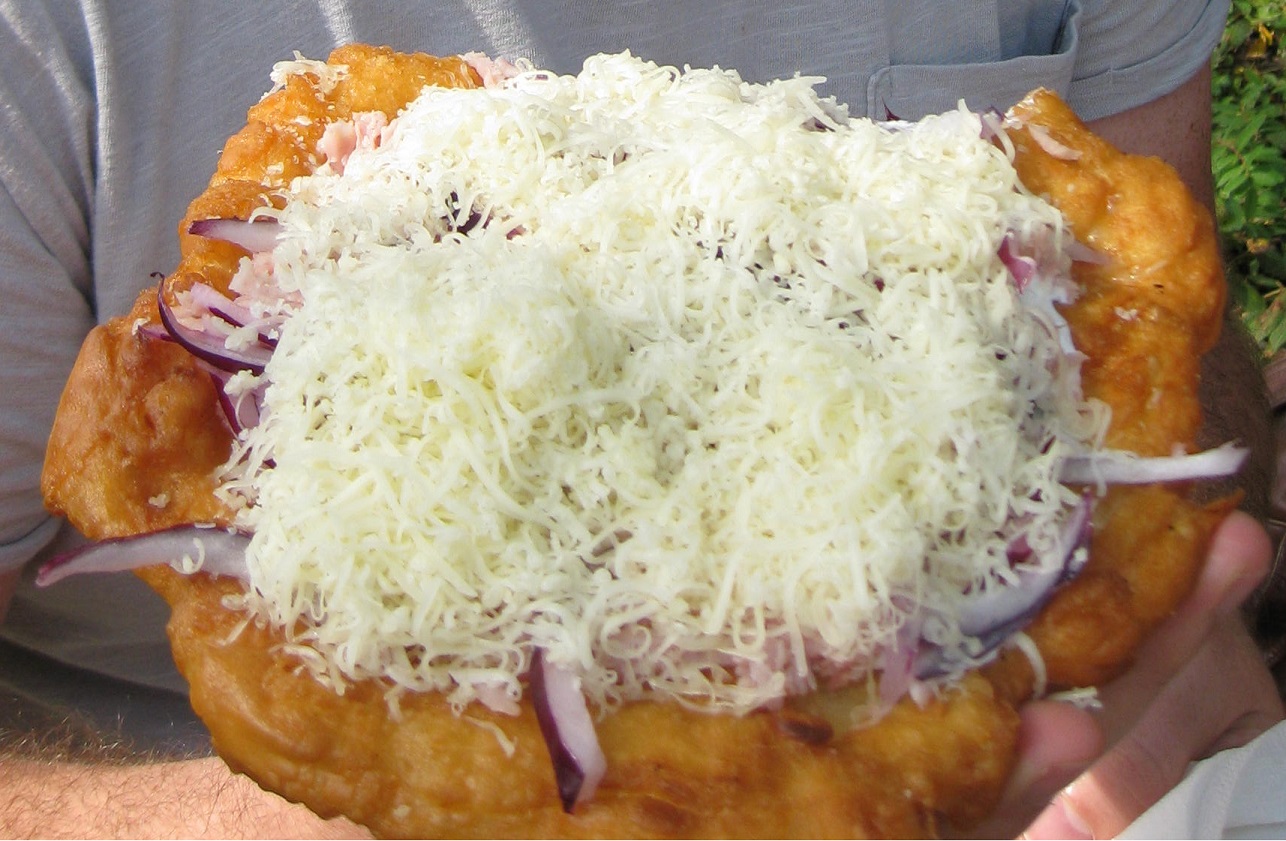 This is a cool indoor market, right near where we stayed. Our host said that the cheese here was great, though we can only testify to the apple strudel (delicious), the yogurt (quite fresh), the bread (decent), and the lángos (a heart attack waiting to happen, but delicious). We spent the rest of the day trying to walk off this fried dough frisbee, topped with sour cream, cheese, ham, and red onions. At dinner time, some of us still weren’t hungry. Perhaps locals use it as a sleeping pill?
This is a cool indoor market, right near where we stayed. Our host said that the cheese here was great, though we can only testify to the apple strudel (delicious), the yogurt (quite fresh), the bread (decent), and the lángos (a heart attack waiting to happen, but delicious). We spent the rest of the day trying to walk off this fried dough frisbee, topped with sour cream, cheese, ham, and red onions. At dinner time, some of us still weren’t hungry. Perhaps locals use it as a sleeping pill? - Chain Bridge: Much
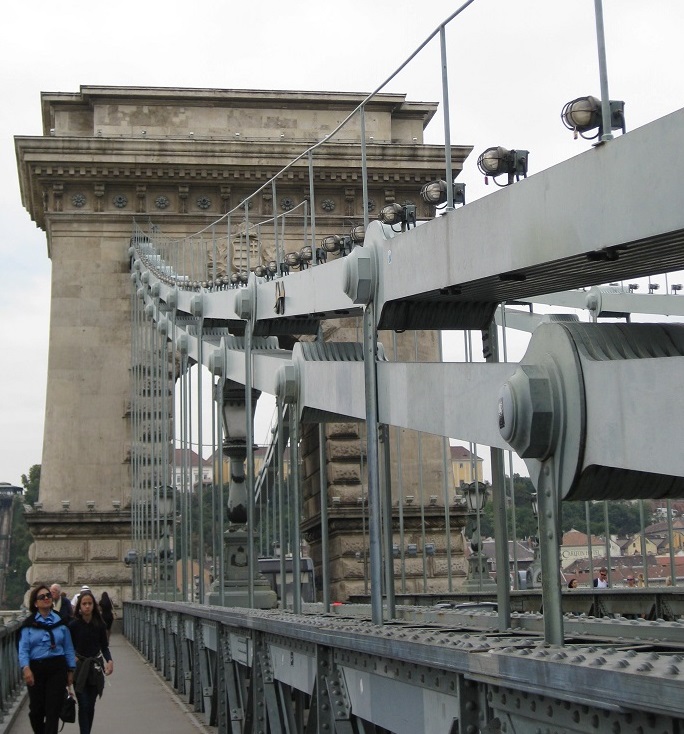 like the Brooklyn or the Manhattan Bridges, where the primary reason to do it – aside from saying you did – is cooling off on a hot day. In other words, nothing amazing here. And the NYC ones offer a better view, in my personal opinion. That said, it was likely significantly cooler before the Germans bombed it on their way out of Hungary, so I’ll add some points based on that assumption.
like the Brooklyn or the Manhattan Bridges, where the primary reason to do it – aside from saying you did – is cooling off on a hot day. In other words, nothing amazing here. And the NYC ones offer a better view, in my personal opinion. That said, it was likely significantly cooler before the Germans bombed it on their way out of Hungary, so I’ll add some points based on that assumption. - Memento Park:
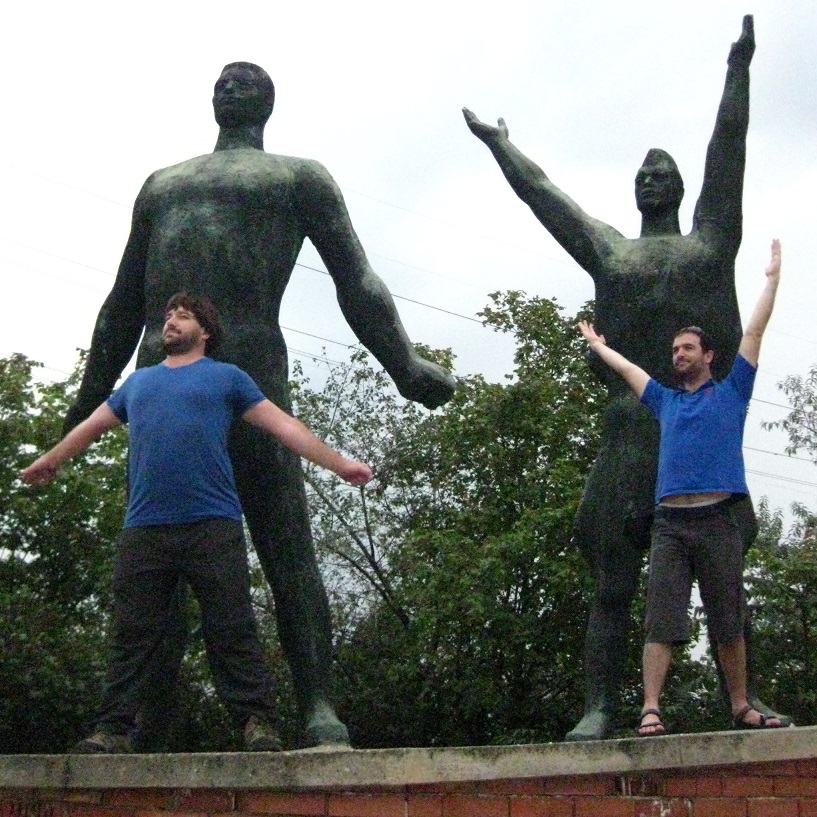 We had way too much fun at this park full of old statues of Communist leaders. The city (and country) wanted nothing to do with them after they kicked the Soviet Union to the curb, but some enterprising individual said, ‘Wait! Let’s put them out in the middle of nowhere, and do a lot of marketing, so tourists spend money getting there and getting in!’ And so it was. But then we posed with every statue, replicating its ridiculous positioning, making it significantly more fun than they likely anticipated. After that, we didn’t mind the trek out of Budapest. The labels still show the original statue titles, which laud the Russians for liberating the Hungarians…from having food and decent wages? Political views aside, it’s fun to imitate everyone from Lenin to random men who seem to be making semaphore signals.
We had way too much fun at this park full of old statues of Communist leaders. The city (and country) wanted nothing to do with them after they kicked the Soviet Union to the curb, but some enterprising individual said, ‘Wait! Let’s put them out in the middle of nowhere, and do a lot of marketing, so tourists spend money getting there and getting in!’ And so it was. But then we posed with every statue, replicating its ridiculous positioning, making it significantly more fun than they likely anticipated. After that, we didn’t mind the trek out of Budapest. The labels still show the original statue titles, which laud the Russians for liberating the Hungarians…from having food and decent wages? Political views aside, it’s fun to imitate everyone from Lenin to random men who seem to be making semaphore signals. - Buda Castle: This wasn’t super exciting, sadly; perhaps because we didn’t go inside? I’m glad that we didn’t walk up the many stairs or wait in an hour-long funicular line to get there, given this fact. We did see the changing of the guard, which was fun. I’m not sure if anything still happens inside the castle, other than National Gallery exhibitions, but it looked like an okay view for former rulers, at a minimum.
- Matthias Church:
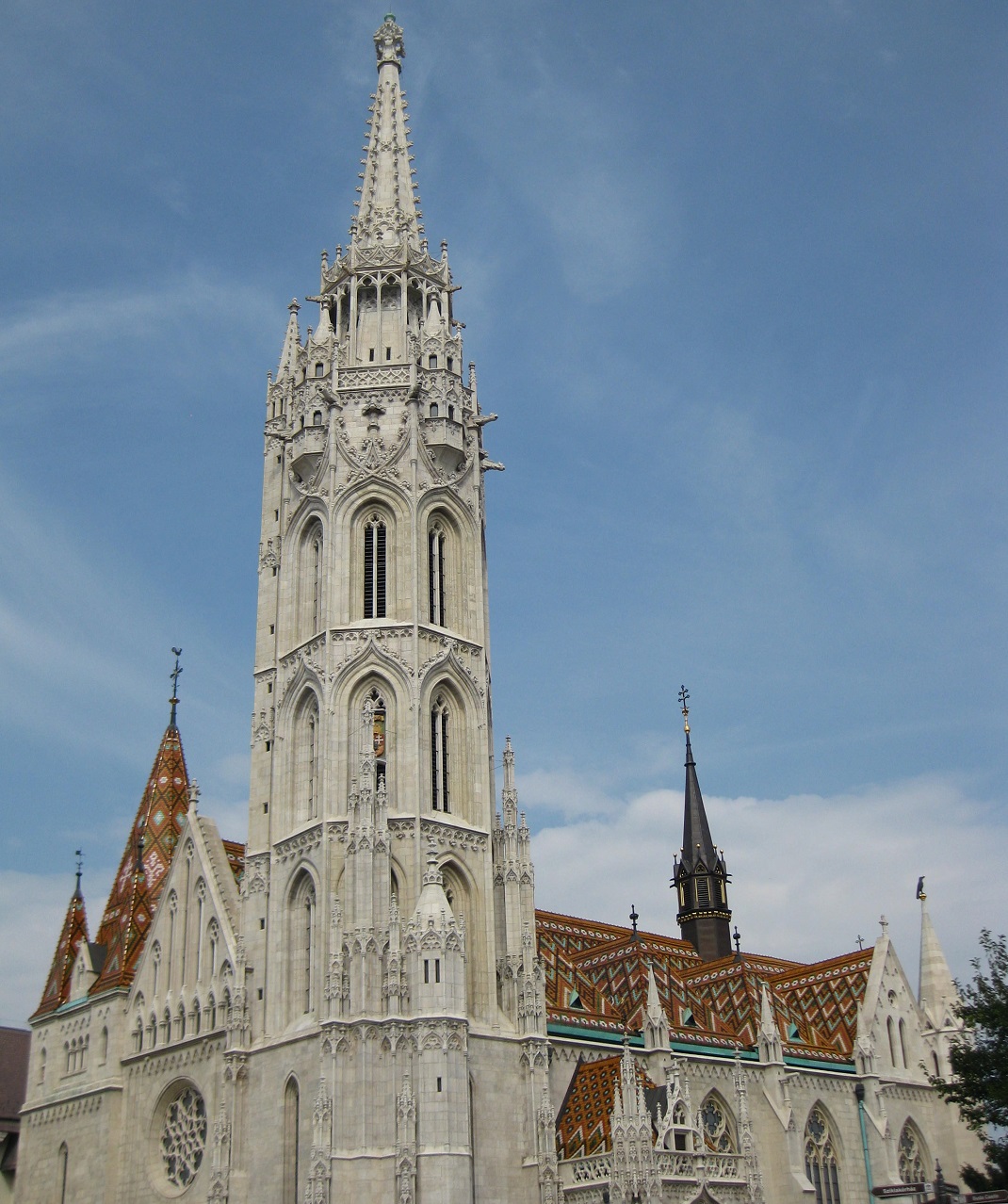 We didn’t go inside, so I’m borderline on whether to list this here, but I liked the outside a lot. The roof was covered in brightly-colored plastic-looking tiles, in hues of terra cotta, olive, cerulean, and milk chocolate. (Yes, I know that those are silly color names, since two of those are foods and one a building material, but I persist.) With the different colors laid out next to each other, the roof looked like a large mosaic! It turned out that while the church was fairly old, the roof itself was only decorated around the same time my great-grandparents were born. Next time, we’ll hopefully see what’s inside.
We didn’t go inside, so I’m borderline on whether to list this here, but I liked the outside a lot. The roof was covered in brightly-colored plastic-looking tiles, in hues of terra cotta, olive, cerulean, and milk chocolate. (Yes, I know that those are silly color names, since two of those are foods and one a building material, but I persist.) With the different colors laid out next to each other, the roof looked like a large mosaic! It turned out that while the church was fairly old, the roof itself was only decorated around the same time my great-grandparents were born. Next time, we’ll hopefully see what’s inside. - St. Stephen’s Basilica: This is the church of the city: the one that is the same exact height as the Parliament building. We saw the outside, and it was nice enough. But we didn’t go inside, and I read that there’s a good city view on top. Next time, hopefully.
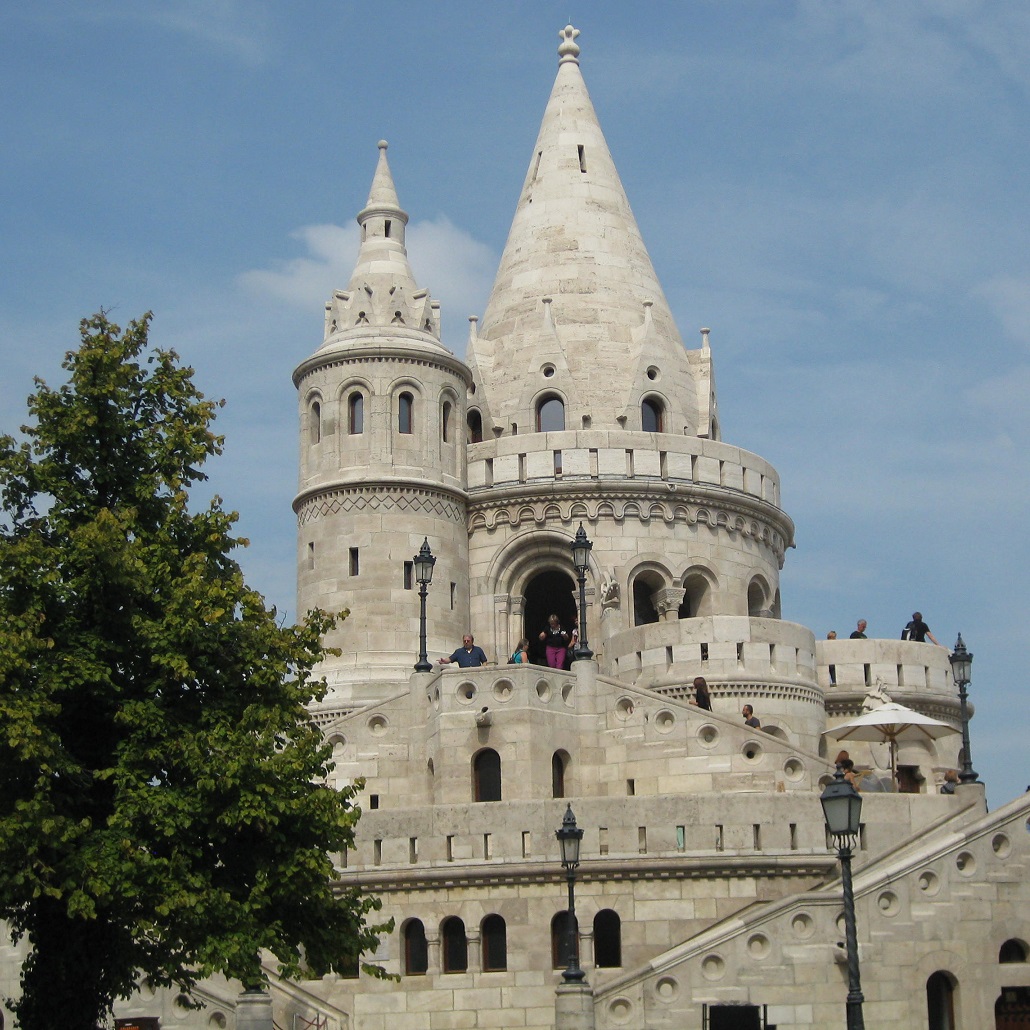
- Fisherman’s Bastion: I didn’t actually know we were here until I looked this up at home, since I’m not clear on what it has to do with fishermen. It’s a bunch of Disney-looking white castles overlooking the river, all with good views and varying levels of tourist-ery. Nice breezes though.
- Shoes on the Danube:
 This is a memorial to Jews lined up along the river, told to remove their shoes, and shot by Arrow Cross militiamen – so their bodies would fall into the river and make clean-up unnecessary. I suspect that many miss the point of the installation, since the small plaque doesn’t make it clear that the Arrow Cross party was basically Hungary’s Nazi party. Probably not worth visiting, unless you’re near Parliament; I was personally more moved by the shoe memorial in DC in the early 2000s, dedicated to Iraq War casualties. Though perhaps I would have felt differently if we had gone here after going to the Terror Museum. The shoes themselves seem to be made of metal, and some hold wilted flowers left by earlier visitors. Except for one person, whose memoriam was less floral and more confectionery in nature: there was a Ukrainian caramel candy (that I love) inside one of the men’s shoes. Behold my restraint: I didn’t even eat it.
This is a memorial to Jews lined up along the river, told to remove their shoes, and shot by Arrow Cross militiamen – so their bodies would fall into the river and make clean-up unnecessary. I suspect that many miss the point of the installation, since the small plaque doesn’t make it clear that the Arrow Cross party was basically Hungary’s Nazi party. Probably not worth visiting, unless you’re near Parliament; I was personally more moved by the shoe memorial in DC in the early 2000s, dedicated to Iraq War casualties. Though perhaps I would have felt differently if we had gone here after going to the Terror Museum. The shoes themselves seem to be made of metal, and some hold wilted flowers left by earlier visitors. Except for one person, whose memoriam was less floral and more confectionery in nature: there was a Ukrainian caramel candy (that I love) inside one of the men’s shoes. Behold my restraint: I didn’t even eat it. - Hungarian Parliament: The architect based this elaborate building directly on Westminster Abbey in London –
 and then added a dome. It was the longest parliament building in Europe, until Romania took up the challenge and insisted on making one several feet longer. Length wasn’t all that mattered: the height of this government building was also in contention. Originally the exact same height as the big church in town, it was added onto by the Soviets, for whom the state had to trump religion: they placed a big, honking Communist star on top. Surprisingly, it wasn’t at Memento Park; perhaps it was destroyed in a fit of rage. I could look it up, but that would ruin the romantic story.
and then added a dome. It was the longest parliament building in Europe, until Romania took up the challenge and insisted on making one several feet longer. Length wasn’t all that mattered: the height of this government building was also in contention. Originally the exact same height as the big church in town, it was added onto by the Soviets, for whom the state had to trump religion: they placed a big, honking Communist star on top. Surprisingly, it wasn’t at Memento Park; perhaps it was destroyed in a fit of rage. I could look it up, but that would ruin the romantic story. - Alexandra Bookstore: This is on the list because it has a café considered to be one of most beautiful interiors for miles. Our initial attempt to see said beauty was foiled by the fact that this bookstore turns out to be a chain. So, be forewarned: do not go to the one next to the Synagogue; go to the one on Andrassy Street instead. When I finally saw it, however, its splendor was ruined by our recent time in Italy. It’s difficult to appreciate frescoes with your coffee when you’ve seen them done by masters in grand churches. On the plus side, they had a section of books in English, where I happily read a romance novel. After some indeterminate amount of time, a kind employee came over to pull me out of my haze, since apparently, the store was almost completely closed down. Oops.
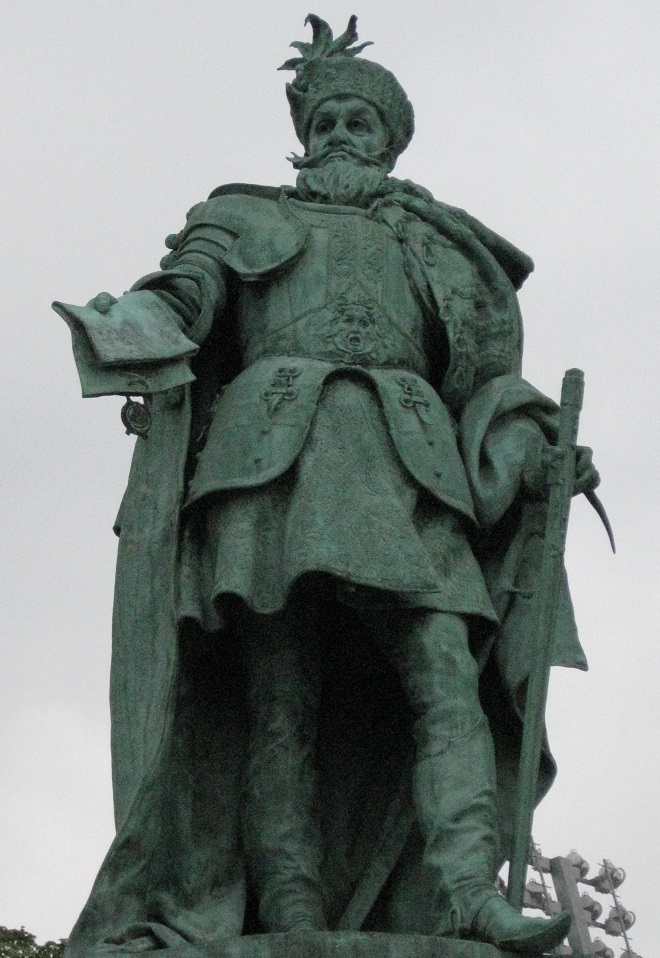
- Heroes’ Square: This is a large square with an angel statue on a tall post in the middle. There are some very ferocious-looking warriors on horses below her, also in statue form. The exterior of the square features seven ‘heroes’ from a long time ago, who look marginally less angry. And then there are some crazed-looking horse statues near them. There are some museums on the perimeter, which I imagine must be the more interesting part.
- Budapest Opera House: Pretty interior, but nothing mind-blowing (except the number of tourists in there).
- Dohany Street Synagogue: We tried to go inside three different times, but it was not to be. This is one of largest synagogues in Europe, with a 3K capacity! The outside is interesting though: it has stars of David everywhere: 28 of them on just one post of the gate, for example. There’s also a cemetery commemorating Jews killed in the Holocaust. And the back garden has a memorial sculpture as well, in the shape of a weeping willow.

- House of Terror: This was a difficult place to go. I understand why B wanted to see it, and I really think I understand Hungary and its history a lot better now – though B says he understands their meekness less. Moreover, I’d say that I enjoyed the Polish version. Anyway, all of that said, this museum made me sad and upset. It was the former headquarters of, first, the Hungarian Nazis (called Arrow Cross Miliatiamen – and with an insignia that was two crossed arrows, not the swastika) and then, the Socialists.
In the building itself, many people had been tortured, interrogated, and killed. And it explains why, at the Polish Terror museums, I kept being surprised that the incarcerated Poles ever came back: the Hungarians did not. It seems to be because arrested Poles stayed in Poland, while many of the Hungarians were sent directly to Russian labor camps. However, it also seems that the Hungarian leadership was more complicit and willing to commit atrocities; I wonder why that is.
The museum has many video screens on which Hungarians who survived into the 1990s gave testimony of their experiences. Watching their faces as they described things that I can’t even call horrors or atrocities was hard. I mean, how do you watch a 70-year old woman’s face as she tells you how the Soviets came, took a fancy to her, and then she can’t even continue to describe what was done to her.
The two biggest surprises for me were:
- In the census after the end of WWII, 1.5% of the Hungarian population (about 100K) self-identified as Jewish. Now maybe the punishments for mis-reporting were strict, and I know the Budapest ghetto was not destroyed like the others. However, the Russians were well-known for hating Jews (hello pogroms), and more information was coming out about the scope of the Holocaust – and therefore the anti-Semitism in the world. Why would you, in that scenario, admit to being Jewish? B thinks that they might have expected reparations, but I’m not sure.
- I know that I lived through the end of the Soviet era, so I should know better. However, I had always heard that Hungary was second to gain independence (after Poland), and I kept thinking that it happened earlier. In fact, the first free elections in Hungary were in 1990, and the last prisoner-of-war didn’t return to Hungary until 2002! That seems like yesterday.
What We Skipped
- Szamos Marzipan Museum: The gift shop had much the same display: marzipan in the shape of characters like the Smurfs, marzipan-created paintings, and marzipan of every flavor and shape under the sun. We figured we saw the free version.
- Central Market Hall: My cousin said that it was very touristy, and we had a better market (see above) right next to us.
- Vajdahunyad Castle: It’s fairly recent (1896), and I took a photo of the outside, so I felt pretty accomplished on this front.
- Robert Capa Museum: Not enough time for this one.
- Museum of Fine Arts: We’re pretty Egyptian-ed and Renaissance-d out.
- Budapest Eye Ferris Wheel: The line was long. Meh.
- Ruin Pubs (like Szimpla Kert, Fogasház, Ellátó Kert): Our host described these as crumbling, war-damaged buildings, which have been opportunistically reclaimed by pubs with insufficient liability insurance. They let you wander around the historic rubble with your beverage, like a visitor to a brick cemetery. However, when we walked through an area with a lot of them, they were laid out like a courtyard between streets, and not as much as I expected was crumbling.
- Gellért Hill: This is the highest peak of the city, named after Saint Gerard. The goal is to hike to the Citadel at the top, and see viewing platforms along the way. We didn’t have the time for this, sadly.
- Cave Tours: The description sounded much like the cave tour we went on in California. It was fabulous, so we wanted to repeat the experience, but we decided to do some things more unique to the area instead.
- Hungarian National Gallery: They had a cool Dali, Duchamp, etc. exhibit that I really wanted to see, but it wasn’t in the cards.
- Mai Manó House of Photography: Not enough time, sadly.
- Danube River Cruise: I have trouble bringing myself to do these, because they’re so touristy. We were going to try a commuter boat instead, but we arrived at completely the wrong time for that and weren’t going to wait for an hour.
- Baths (like Széchenyi Bath, Rudas Bath, Lukács Bath, Rác Bath): These are Turkish baths, since they’re all on the Buda side of Budapest, which was formerly Turkish-ruled. We really wanted to go to one of these, but it’s a few hours’ experience, and we visited one in Turkey – and more recently, in Acqui Terme. If that’s not the case for you though, this is a must-do, since Budapest is known as the City of Baths. Also, if you go to the most famous one (Széchenyi), our host recommended leaving everything but your towel, flip flops, and entry fee in your room. There have been some locker break-ins and bike thefts there, likely because of the preponderance of tourists.



Pingback: The Best Budapest Ruin Pubs - the Hostel Rocket blog about budget travel
This was so helpful for my planning! Thanks Nastya 😉
and Brandon
Pingback: Growing a (Temporary) Heart - Novelty Buffs
Pingback: Memorable Moments in Budapest - Novelty Buffs
Pingback: What We Saw in Singapore - Novelty Buffs